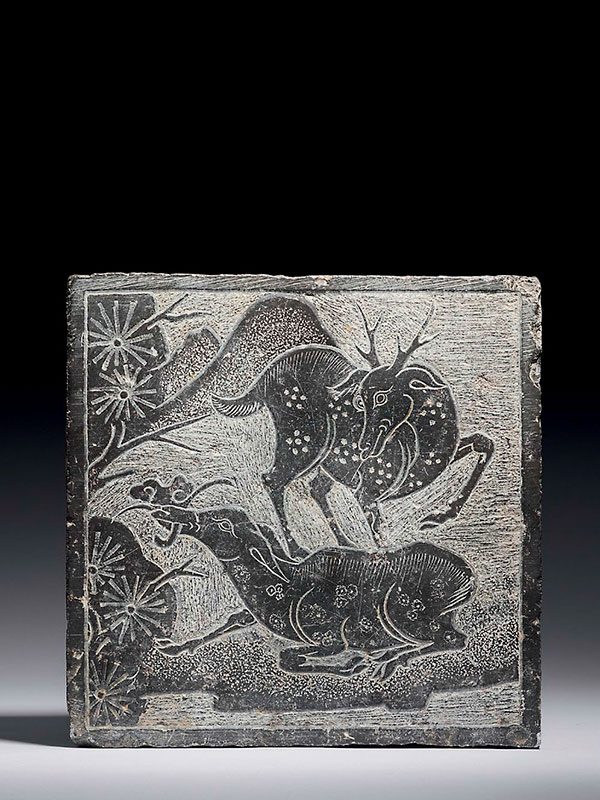Stone panel carved with two deer
A grey stone panel of square format, the front carved in low relief with a couple of spotted deer on a riverbank and with stylised mountains and pine trees in the background. The recumbent doe holds a spray of lingzhi fungus in her mouth. The stag with prominent antlers stands watch over her with its head turned. The background is indicated by fine linear incisions and stippling.
Deer are associated with the Daoist cult of immortality since at least the Han dynasty (206 BC – 220 AD) and are regarded as auspicious animals. Especially spotted deer were believed to have the ability to locate the lingzhi fungus of immortality,[1] hence the spray of lingzhi fungus in the doe’s mouth; another auspicious reference to longevity. Deer also symbolise riches, because in the Chinese language the word for deer, lu, is phonetically equivalent to the word lu meaning good income. The original purpose of this charming stone panel is unclear. However, its format reminds us of Han dynasty clay bricks moulded with relief decoration that were made for the foundation of architecture. A rubbing of a Han dynasty brick relief depicting a stag with antlers, originally made for a palace, is in the collection of the National Palace Museum, Taipei.[2] The present stone panel may have been part of a decorative scheme in a house, or could have been inserted into a piece of furniture. A closely comparable stone relief depicting a spotted stag with a branch of lingzhi fungus in its mouth is illustrated by Welch.[3] A square ink cake with a spotted black stag motif, dated to 1573, is in the collection of the Metropolitan Museum of Art, New York.[4] A jade brush rest carved with a couple of deer with lingzhi fungus, dated to the Ming dynasty, was formerly in the Qing Court collection and is now in the collection of the National Palace Museum, Taipei.[5]
- Welch, P. B. Chinese Art- A Guide to Motifs and Visual Imagery, Tuttle Publishing, Singapore, 2012, p. 116
- National Palace Museum, Taipei online collection archive, no. 贈拓19
- Welch, P. B. op. cit, p. 116, fig. 237
- Chinese Decorative Arts – The Metropolitan Museum of Art Bulletin, vol. 55, no. 2, Summer 1997, p. 55
- National Palace Museum, Taipei online collection archive, no. 故玉 564
鹿銜靈芝紋石磚
明末至清初 十七世紀中
長:21.5 公分 厚:6 公分
方形石灰岩磚,邊框起線,正面淺刻梅花鹿一對,後襯遠山松樹。母鹿臥於地,右前肢前伸,頭
微仰,口銜靈芝一束。公鹿立於母鹿身後,左前肢微揚, 回首望向前方母鹿,鹿角聳立。兩鹿
雙目圓睜,神采飛揚,身上斑點以淺刻斑點表現,足現刻工細膩。背景劃滿細線,呈現如白底效
果,與主要紋飾所保留的灰石原色,形成強烈對比。道教傳說中,西王母乘白鹿之說,以及梅花
鹿可保衛並尋得靈芝,已於漢朝時存在。鹿的發音又與「祿」相同, 意為俸祿,是以鹿銜靈芝象
徵「福祿長壽」或「福祿如意」。本石磚的原始用途不明,其形制與漢代畫像磚及後代磚雕相呼
應,或許同為建築裝飾之用,然而本品卻以石灰岩雕刻而成,著實罕見。臺北故宮博物院藏有一
件漢代銅雀宮鹿畫像磚拓本,飾以一公鹿昂首茁立。美國紐約大都會博物館藏有一方墨,墨面淺
浮雕公梅花鹿一隻,依銘刻定年為1573年制。以鹿銜靈芝為主題表現之文物,亦可見於其他媒
材,如臺北故宮博物院藏一件白玉雙鹿筆架。

